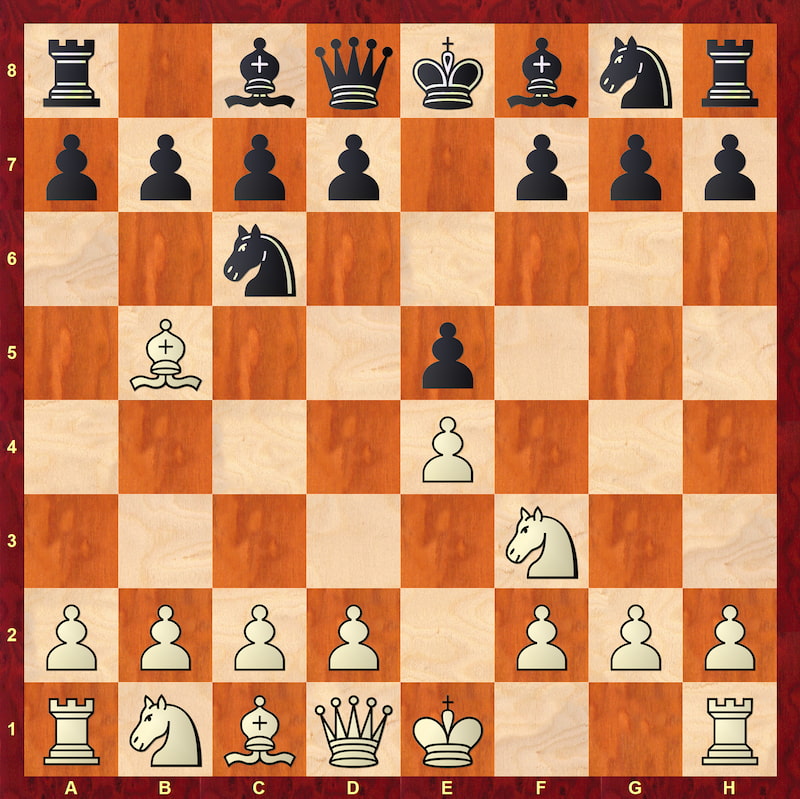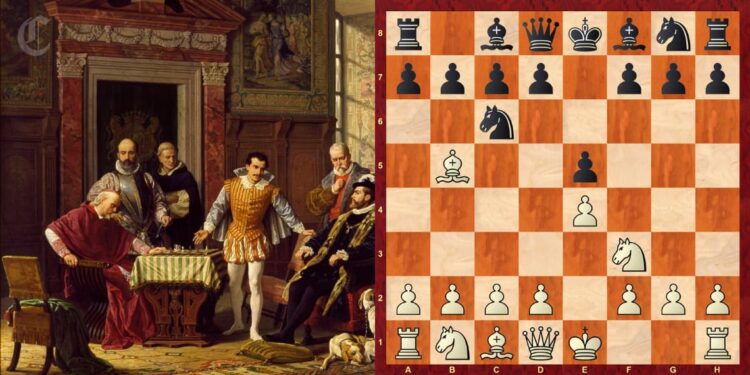1. e4 e5 2. Nf3 Nc6 3. Bb5

Table of Contents
- History
- Move-by-Move Sequence
- General Strategy
- Examples
- Strengths
- Weaknesses
- Variations
- Frequently Asked Questions
- Conclusion

History
The Ruy Lopez opening, also known as the Spanish opening or Spanish Game, has a rich history and is utilized by beginners and grandmasters alike. It’s named after Ruy López de Segura, a 16th-century Spanish priest who was well known for his extensive study of chess openings in the book Libro del Ajedrez, published in 1561.
The opening helps gain spatial advantage for white and branches off into complex variations. For now, we will focus on the basics of this innovative opening.
General Strategy
The Ruy Lopez opening is a popular opening for the White pieces. Let’s examine the chessboard and discuss the opening sequence together. The Ruy Lopez opening develops into aggressive and tactical games.
However, it can result in some slower progressions and subtle outcomes. There are many variations to consider that fit many play styles. It is widely utilized by novices and professional competitors. Eventually, you’ll gain a solid understanding of how to start playing it yourself!
When to play it
The Ruy Lopez opening should be studied continually if you’re dedicated to the sport because it will continue to occur in casual and tournament settings. Play through games that feature it to gain insight into development, position, and tactics. Learn from skilled players who are experienced in the opening and ask for advice while taking notes.
If your Elo rating is on the line, then only play it if you’ve absorbed the basic principles and variations. The Ruy Lopez opening starts off with the King’s pawn e2 to e4 so examine this first from both sides to recognize when it’s played.
Grandmasters consider this to be a stronger opening because it allows for easier development of two major pieces, namely the queen and bishop with the open square on e2. The best way to learn is to practice and observe the responses of other beginners to this popular opening.
You will learn the common sequences by simply playing, and the variations will be cemented in your memory.Until then, take notes and enjoy learning this opening that leads to exciting possibilities in the middle and end game!
When Not To Play It
If you’re playing against a more skilled opponent, then it would be wise to go with the more comfortable queens pawn opening. However, if you’ve thoroughly digested this guide and are familiar with variations of the Ruy Lopez, then test your skills against a stronger player who is also acquainted with this quintessential opening for an exciting lesson.
One of the main goals of chess is to learn, and playing an unfamiliar opening against a stronger player will result in a loss. You learn from this because the mind will adapt and remember what went wrong. It’s best to practice it against either low-level training software or players who are new to the basic opening principles.
Every game has something new to teach you, and this is the case at the highest level.
Move-by-Move Sequence
The sequence of the main line is 1.e4 e5 2.Nf3 Nc6 3.Bb5.
e4
is an excellent starting move because it takes control of the center e4 square and also influences the important d5 and f5 squares because remember that pawns capture diagonally in chess. Most of the time you will see black respond with e5, but another common move that might throw you off, in the beginning, is c5, otherwise known as the Sicilian defense which is perceived to result in a more equalized position for black.
Knight from g1 to f3
Notice that this puts pressure on the black e5 pawn and forces them to address this. It also accomplishes a powerful developing move for white simultaneously.
Remember that a good opening puts emphasis on the development of your army to properly engage in a successful attack during the mid-game. Moving the knight to f3 also gives white influence over the important d4 central square.
Another rule of thumb regarding effective openings is to always aim to influence the center of the board. F3 is also serving one more purpose which is it further opens the kingside for a quick and effective castling which is where you get the king into safety by moving him to g1 and the rook to f1 only when the space is open.
Black Responds with Nc6
This protects the pawn on e5, develops a minor piece, influences the central squares of d4 and e5, and also prepares black for a potential queenside castle.
Bishop from f1 to b5 Pressuring The Knight
This effectively puts pressure on the knight which is already stressed in protecting the e5 pawn. The knight cannot move because then the pawn on d7 will be stuck in place because of the bishop’s influence resulting in a pin to the king.
You can see that white is putting on the pressure in this opening, but it is far from over if you’re playing black is exciting! Don’t panic when you see that bishop invade your space on the defensive side, and consider a wise and calm response.
Examples
Here are some active demonstrations of this opening used in real competitive chess games to take note of for future reference. Observing other games of all skill levels is one of the best ways to learn next to playing chess itself.
Example #1
Example #2
Example #3
This example is a game played between Adolf Anderssen and Gustav Richard Neumann in 1865.
General Strategy For After The Opening
After the opening sequence, the general strategy of both players is to achieve central dominance, but black is usually on the defensive during the first part of the game. Many players will agree that white carries with it a slight advantage when playing the Ruy Lopez, but remember that black has an entire army at their disposal and can be a thrilling victory if you defend properly. After the knight is pressured, black can respond with pawn a7 to a6 and put the threat to the bishop and forcing white to take action.
White can then either choose to capture the knight on c6 resulting in doubled pawns and less coherent structure for black, or you will see players commonly retreat the bishop on b5 to a4. This is a reliable move for beginners because it keeps the bishop in a safe yet influential position.
The strategy of black is to fend off this rather aggressive attack on the white’s part while fighting for central dominance and continued development to get the king to safety as quickly as possible. White will try to inhibit this by putting on more pressure and asserting their central influence to cramp black’s position and infiltrate with weaknesses.
The best move for white after the bishop is accounted for is getting the king to safety with a preservative castling move on the king’s side.
Strengths
The Ruy Lopez can be a great opening for white to gain central control and throw off opponents who aren’t aware of its intricacies. It accomplishes all of the basic functions of a strong opening including the development of the center, applying pressure on black to move, and preparing for getting the king to safety expediently.
Most new players tend to overthink when that bishop creeps up and puts the question to the knight, and it might be tempting to move it, but never give in to that. It’s better to let them conduct the exchange so that black has a chance for a better-centralized position.
Weaknesses
Commonly in the higher levels of this opening, we observe that white needs to alleviate the center more than black. Remember that black has a whole army with possibilities to push forward and win the game despite white’s attempt at a tactical advantage in the Ruy Lopez opening.
One weakness in black’s position from the start is if the bishop takes the c6 knight which doubles the pawns. Although this isn’t always perceived as a detrimental weakness, it is still mostly unfavorable. White is definitely in the habit of probing black for weaknesses after the opening sequence, but the tables can turn with two high-level players fighting to the death.
Variations
There are 182 variations in total when playing the Ruy Lopez. Piece of cake right? No learning 182 variations of any opening is ridiculous unless you’re legitimately going for your 3rd GM norm. There are six which are most commonly played.
- a6
- Berlin Defense
- a7
- d7
- f8
- Schliemann
a6
The first most common variation is played in 56% of all Ruy Lopez games and that’s where Black’s a6 move forces the bishop to retreat a4 but maintains a decent position with an effective pin on the c6 black knight.
This is the one you want to familiarize yourself with thoroughly because you will see it more than the others during this opening.
Berlin Defense Variation
12% of games reach this next variation and it includes black moving the knight to f6 thereby attacking the white pawn on e4 and is commonly known as the Berlin Defense Variation.
a7
The third result is seen 11% of the time and constitutes black moving the pawn on a7 to a6 which effectively attacks the white bishop on b5. White will naturally capture on c6 which conveniently removes the knight and leaves the black pawn on e5 with no protection. This is known as the exchange variation.
d7
The fourth most common one to consider is where black will push the pawn on d7 to d6 which adds much-needed protection to the c5 pawn. This effectively opens the diagonal to develop the bishop on c8 and is known as the Old Steinitz Defense variation.
f8
Next, we observe the classical defense variation where black moves the bishop from f8 to g5 in preparation to castle, capitalizing on the weak white f2 pawn. This is an elusive and powerful option for black to consider.
Schliemann Defense variation
Lastly, we take note of the Schliemann Defense variation. Here, black will push the pawn from f7 to f5 and this accomplishes great pressure on the e4 white pawn.
Core differences in the variations
Each of these variations serves a specific purpose and gives some unique options for black to defend against the aggressive nature of the Ruy Lopez. Some impressive tactics can be implemented as we observed where white will start to question how sharp an advantage they really have in the long run. Properly defending against this opening is what will serve black in developing a counter-attack and potentially taking control of the game.
The differences in these variations include black’s motives regarding applying pressure and forcing whites to react or retreat. In contrast, supportive moves are implemented by black to strengthen the position and gives them a fighting chance in a potentially hectic board. Always remain calm and consider these variations wisely to address the Ruy Lopez opening.
There is always an answer whereby black can turn the tables and wreak havoc on the board in light of the white’s perceived advantage.
Frequently Asked Questions
What makes the Ruy Lopez opening good?
This opening is advantageous because of its immense flexibility and possibilities in variations with coherent strategies for both white and black. Because this opening is used in almost every chess set, it is good to understand it thoroughly and will broaden your horizons for continued growth.
How does black respond to the Ruy Lopez opening?
Black is initially in a defensive position to ward off the attack of white, but with the proper variations, they can respond to turn the tide and counter-attack effectively by dominating the center.
Is the Ruy Lopez opening viable for beginners?
This opening is accessible to beginners and grandmasters who all learn from each individual game. It has stood the test of time as one of the most reliable openings. It is a fun option to study that will enrich your chess knowledge and better equip you to deal with a common opening situation. Pattern recognition will become automatic through deliberate study so view each loss as stored data.
Conclusion

